Also known as the portia tree, Thespesia populnea is an attractive, small-to-medium sized tree in the mallow family, Malvaceae often used ornamentally for its flowers, fruit, and handsome wood grain. Native to various coastal and island regions including Hawaii, the South Pacific, southern Florida, parts of Asia, and Africa, Thespesia populnea thrives in warm, humid, sunny climates and is relatively fast growing compared to other hardwoods.
The trees produce vibrant yellow, round flowers which later develop into large, rounded seed pods filled with bean-like seeds enveloped in fibers. The heartwood ranges in color from tan to dark reddish brown and is commonly used for carvings, furniture, and cabinetry. Thespesia populnea is also an important source material for traditional barkcloth production across the Pacific islands.
Here are the Common Names of Thespesia Populnea in Different Indian Languages:
Hindi: पारीजात (Parijat)
Bengali: পারিজাত (Parjatak)
Telugu: పారిజాతము (Parijatamu)
Marathi: पारिजात (Parijat)
Tamil: பாரிஜாதம் (Parijatham)
Malayalam: പാരിജാതം (Parijatham)
Kannada: ಪಾರಿಜಾತ (Parijata)
Natural Habitat and Growing Conditions
In its native range, Thespesia populnea grows in coastal environments, disturbed areas, and dry forests in USDA zones 10-12. It tolerates high heat, salty air, loose sandy soil, limestone substrates, and high winds. The trees fare best with consistent warmth, 70 degrees F and higher year round, and high humidity. They require full sun and generally abundant water, especially when young, but mature trees can withstand short seasonal droughts once established.
Read About How to Grow Syzygium Jambos | Rose Apple here
Starting Thespesia Populnea from Seeds
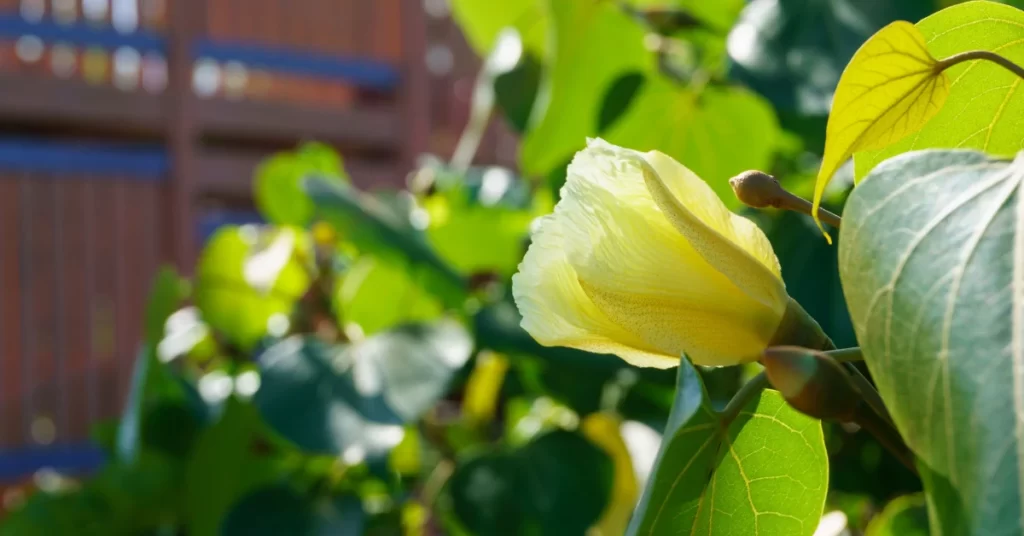
Growing Thespesia populnea trees from seeds allows you to propagate new saplings identical to the parent tree, carrying on desirable characteristics like flower color, fruit production, or wood qualities.
Gathering and Preparing Seeds
Collect ripe, dry pods once they split open, revealing the seeds encased in cotton-like fibers called kapok. Remove and dry the bean shaped seeds, discarding those that appear underdeveloped or damaged. Before sowing, you may wish to soak or scrub seeds gently to remove excess fiber which could impede germination.
Alternatively, plant seeds directly with kapok intact as this may protect them and help retain moisture. If planting in containers indoors, use sterile potting mix for best results. For garden beds, prepare soil by loosening, removing weeds/debris, and mixing in aged compost or manure.
Planting Seeds and Caring for Seedlings
Sow seeds 1 inch deep spaced several inches apart, keeping soil consistently moist but not saturated. Expect germination within two to six weeks when temperatures average 70-80 F. Water daily to keep surface slightly damp and fertilize monthly with balanced liquid feed once seedlings grow beyond the cotyledon stage.
Transplant into larger containers when true leaves appear, replanting progressively until saplings reach 1-2 feet when they can be placed in prepared outdoor sites. Shelter young nursery plants from harsh sun and wind. Control spider mites, aphids, or fungi with appropriate organic sprays if pests arise indoors. Harden off before transplanting outside over two weeks.
Discover How to Grow Vitex Negundo here
Transplanting Thespesia Populnea Saplings
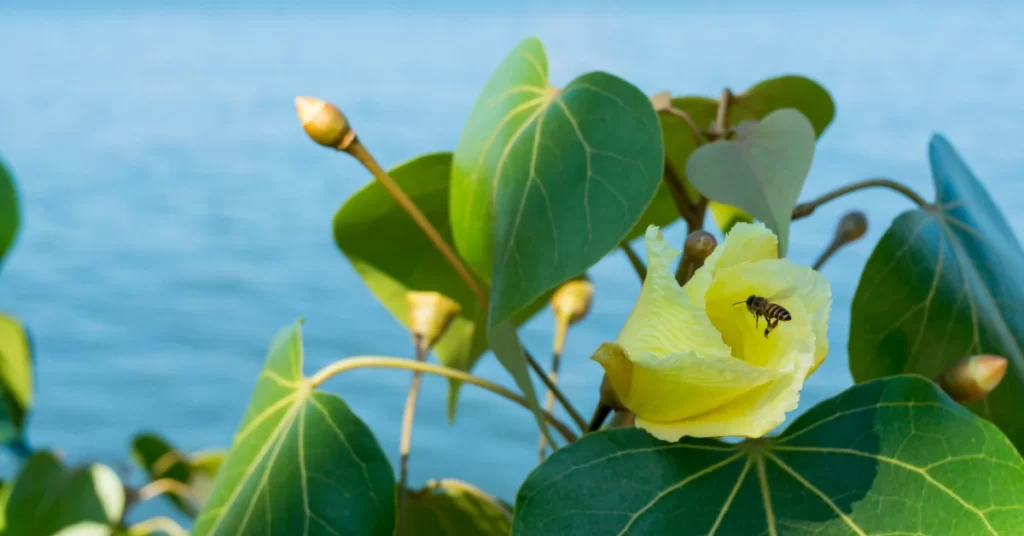
Selecting a Planting Site
Choose a site replicating Thespesia populnea’s preferred growing conditions – well draining soil, coastal proximity, full sunlight, shelter from high winds initially. Avoid frost pockets as young trees won’t tolerate any freezing.
Space multiple trees 20 feet apart for landscape plantings, allowing ample room to develop. Check for subsurface pipes, cables, etc when digging.
Digging Holes and Preparing Soil
Dig holes 2-3 times wider than root ball, approximately 2 feet deep or slightly shallower than nursery container. Roughen sides and bottom to promote root penetration outward into surrounding soil.
Partially backfill with mix of topsoil and aged compost/manure, forming mound to support root ball slightly above ground level to prevent settling or water pooling at base. Remove any binding cords/containers before placing in hole to prevent girdling stems later on.
Transplanting Process
Water saplings thoroughly beforehand. Carefully place each into prepped hole, positioning straight and keeping root ball intact. Loosen any encircling roots gently. Water again after inserting central stake driven firmly into soil to offer stability.
Backfill carefully around perimeter, tamping periodically to stabilize. Construct earthen basin around perimeter to retain water when irrigating. Water thoroughly again to settle soil completely with no air pockets. Mulch 4 inches deep around base, leaving several inches bare at trunk.
Caring for Young Trees
Monitor soil moisture frequently for several weeks, irrigating whenever surface dries out. Fertilize monthly during growing season with balanced feed. Weed carefully by hand without damaging shallow roots.
After winter dormancy, prune selectively in spring to shape, using proper technique to avoid harming vascular tissues. Remove any dead/damaged branches promptly.
Control insect pests like borer caterpillars with Bt spray if detected. Shelter from cold winds or frost in winter for the first 2-3 years using fabric shrouds if needed until well established.
Learn How to Grow Gmelina Arborea Easily here
Caring for Mature Thespesia Populnea Trees
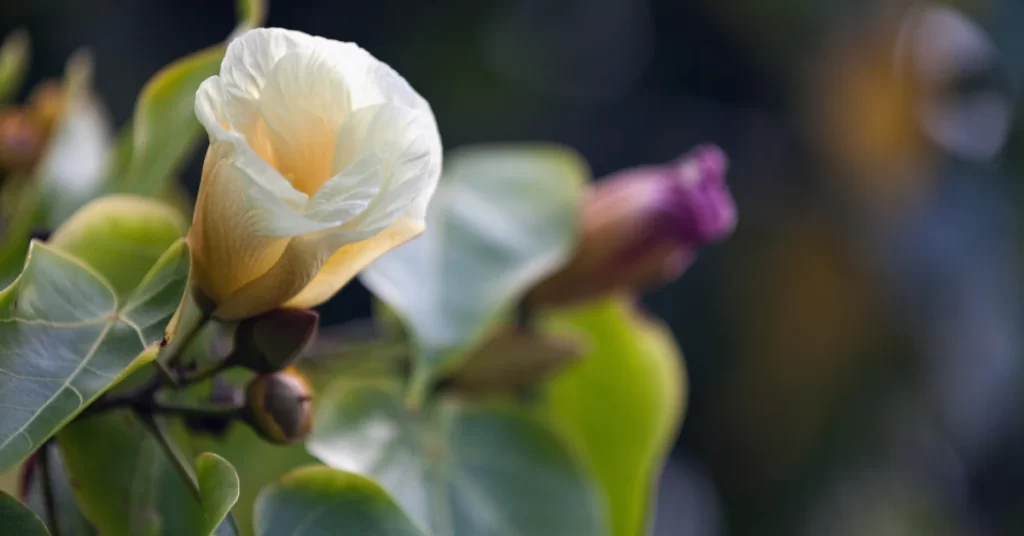
Watering Guidelines
When trees exceed about 4 feet tall with substantial leaf canopy, water requirements decrease and soil should be allowed to partially dry out between irrigations to encourage deep rooting.
Provide about 1-2 inches of water weekly if rainfall is insufficient during warmer months. Reduce in winter but monitor for drought stress like wilting. Well established trees may require no supplemental water in tropical locations aside from prolonged dry periods. The thick bark makes them quite resilient.
Fertilizing Recommendations
Fertilize 3 times annually – at the start of the growing season, mid-summer, and as the growth rate slows in early fall. Use balanced organic feeds or aged manure, spread evenly under the wide drip line rather than concentrating excessively near the trunk which can damage bark tissue.
Prune regularly instead to stimulate new growth and discontinue feeding if adequate growth occurs without supplementation on suitable sites. Excess nitrogen causes leafy growth at the expense of flowering and fruit production.
Pruning Tips
After the sapling stage, minimal pruning is required aside from clearing dead branches annually. Lightly thin developing trees every few years to allow optimum air flow and light penetration inside canopy if desired, removing no more than 15% living matter per season.
Heading cuts into major limbs will spoil natural shape but judicious tip pruning helps restrict height as these are fast growing trees, up to 2 feet annually. Take care not to expose trunks to prolonged direct sunlight which may cause bark burns – prevent with whitewash if needed.
Pest and Disease Control
Thespesia populnea trees are typically quite resilient to infection and infestation, especially with proper cultural care. Ensure adequate spacing, air flow, soil nutrition and try to avoid excess moisture.
Monitor for common insect pests like borers, scale insects, leaf miners, mealybugs or spider mites and apply organic miticide/insecticidal soap sprays at first signs of infestation before extensive damage occurs.
Remove raked debris and pruned branches promptly from the site to eliminate inoculum sources. Rake up and destroy diseased leaves exhibiting spots or lesions quickly. Preventive applications of broad spectrum biofungicides may help suppress some foliar diseases in tropical wet regions if recurring issues necessitate.
Discover How to Propagate Cebu Blue Pothos here
Propagating Thespesia Populnea Trees
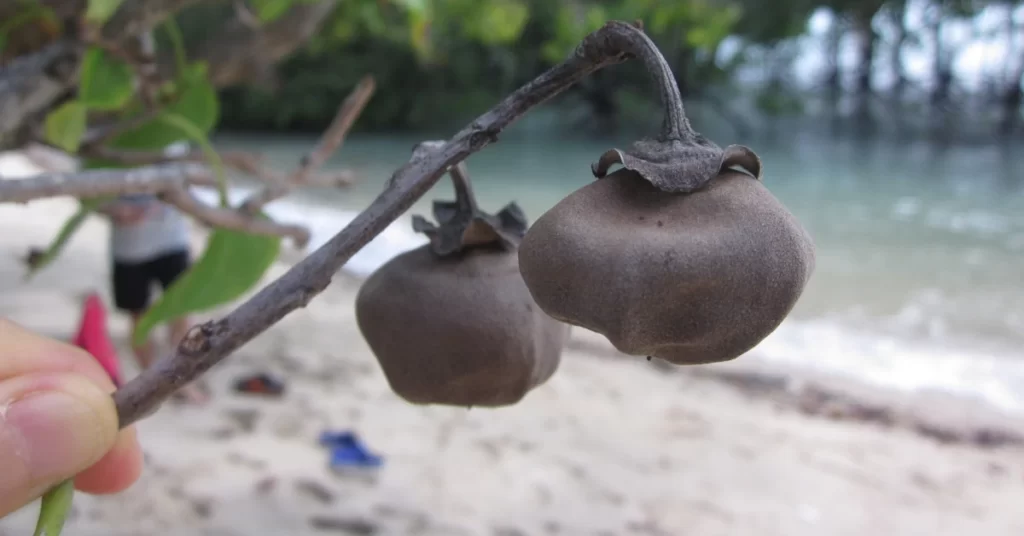
Propagating by Cuttings
Thespesia populnea propagates readily from semi-hardwood cuttings harvested when stems begin maturing, often gaining a slightly woody texture but still actively growing at stem tips. Take 6+ inch trimmings in spring, ideally containing several leaf nodes which aid root initiation.
Trim basal end at 45 degree angle just below a node. Dust with rooting hormone powder/gel to encourage root growth then plant individually in small containers using well draining proprietary soilless rooting media.
Maintain constant warmth and very high humidity, misting often or using enclosed propagation trays until root establishment occurs. Harden off before transplanting like seedlings into outdoor sites.
Air Layering Technique
This propagation method allows asexual cloning of select mature, fruiting trees while still attached, causing rooting directly on stems. Choose low lateral branches and scrape a 2 inch section of outer bark tissue cleanly off at both ends, exposing the moist cambium layer underneath without cutting deeper into wood.
Wrap this wounded section tightly with a handful of damp sphagnum moss, sealing in place with plastic wrap. Dust rooting hormone over the moss if available prior to wrapping. When sufficient roots proliferate through the moist rooting media in a few months, cut below that point, removing the air layer with attached roots to pot up or transplant.
Grafting Methods
Grafting utilizes suitable rootstock saplings for establishing a clone of a known productive tree by surgically joining scion wood from that tree onto the roots of another young tree. Match scion and rootstock diameter closely for best results. Whip grafting in early spring has good success as vascular tissues of both fuse quickly with proper technique.
Various other grafting methods like veneer, chip budding or approach grafts may also produce results depending on timing and materials used. Graft unions should align cambium layers between rootstock/scion for proper healing and nutrient transport across the joint. Wrap grafted site to stabilize until fused fully.
Harvesting Thespesia Populnea Fruit and Wood
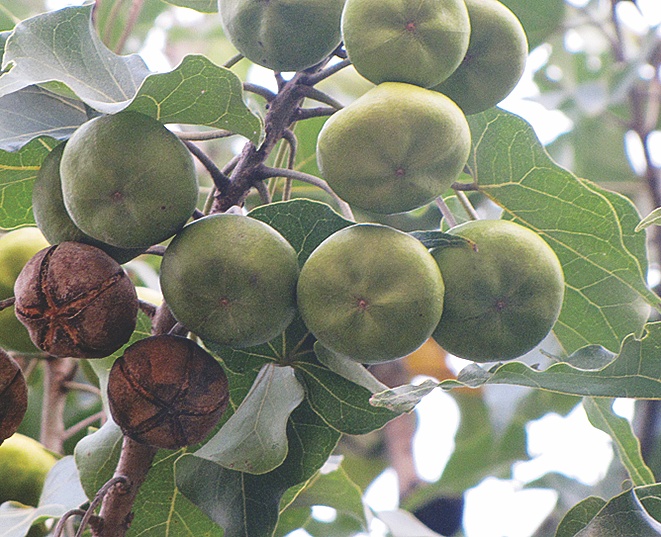
Timing the Fruit Harvest
Monitor developing seed pods closely as they ripen and burst open when fully mature after roughly 5 months from flowering. Harvest promptly before seed fibers disperse widely. Store filled pods or seeds extracted from pods in breathable containers if sowing the next seasonal planting cycle. Refrigerate in sealed bags to maximize longevity.
Collecting and Storing Seeds
Collect fallen pods beneath trees or prune within reachable height to obtain ripe fruits, checking for fully formed seeds. Air dry intact pods further indoors for a couple weeks then pry open to remove drying seeds. Discard any with holes, dark lesions or insect damage.
Place sound seeds in breathable jars/envelopes and store in cool, dark location until sowing. Label by date and parent tree if collecting from various superior specimens for comparison. Viability decreases substantially after one year of storage.
Cutting Logs and Drying Lumber
Harvest heartwood near the base and main trunk for prime lumber rather than smaller branches which produce lesser yields. Cut logs during dormancy before new sap flows using proper chainsaw safety protocols and techniques to carefully direct falling trunks.
Debark logs or planks, then seal end grain to prevent excessive checking/cracking. Air dry appropriately stacked logs in dry, covered storage for up to two years depending on plank thickness, monitoring for pest damage or fungal discoloration. Kiln drying produces stable finished lumber most suitable for fine woodworking applications.
Common Issues When Growing Thespesia Populnea
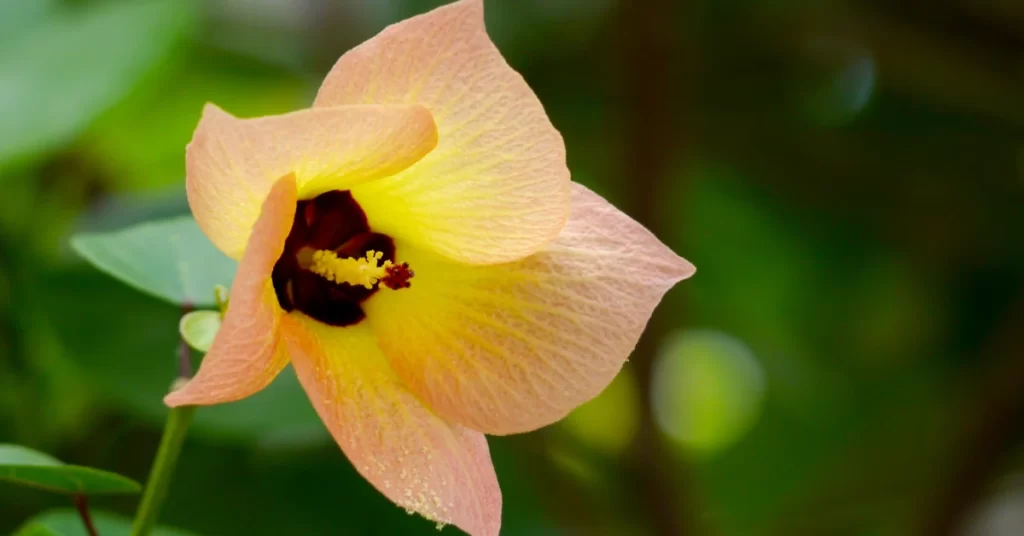
Despite its resilience in the tropics, Thespesia populnea trees may encounter various problems under suboptimal conditions or extreme weather. Monitor for signs of trouble and attempt mitigation promptly.
Seedlings often succumb to stem/root fungi like damping off before transplanting outside when kept too wet indoors. Avoid overwatering, allow soil to dry somewhat between irrigations and use sterile media.
Transplanted saplings may droop severely or defoliate from transplant shock if insufficient watering occurs the first few weeks until root establishment. Shelter from wind may help conserve soil moisture around distressed new transplants if drying foliage appears.
Chlorosis and stunted pale growth results from nutrient deficiencies -confirmed with soil testing and remedied with prompt pH adjustment and fertilizer amendments if necessary to supply key elements like manganese, iron etc.
Insect borers can badly damage or kill small trees under drought stress. Ensure adequate irrigation, avoid mechanical bark damage which attracts them and monitor closely when problems arise. Remove borers manually if detected early or apply Bt spray against larvae according to label guidelines.
Salt burn damage and tip dieback arises for trees located very near ocean shorelines if exposed to salt spray or storm surge flooding. Rinse soil and foliage occasionally to reduce sodium accumulation which pulls moisture from plant tissues osmotically. Shelter with berms or shrubs if needed.
Thespesia Populnea Uses

Ornamental Landscaping
With its vibrant flowers, attractive fruits, and handsome foliage, Thespesia populnea serves well as a tropical ornamental specimen. Its relatively fast growth makes it a good option to add visual interest and provide shade quickly.
Woodworking and Carpentry
Thespesia populnea lumber is prized for carpentry and fine woodworking across its native range. The wood grains beautifully and takes an excellent polish. Common uses include furniture, cabinets, carvings, and handicrafts.
Soil Stabilization and Land Reclamation
Thespesia populnea has been effectively utilized in coastal regions to stabilize sandy soils prone to erosion. Its fibrous root networks excel at holding loose ground. The trees also enrich depleted soils as leaf litter accumulates.
Paper and Textile Production
The inner bark and young shoots can be processed traditionally or industrially to make kapa (barkcloth) fabric used for clothing and materials in Pacific islands. The fibrous kapok surrounding seeds is also used as a textile fiber substitute similar to cotton.
Traditional Medicine
Various plant parts and extracts from Thespesia populnea have long been used in herbal medicine systems. Antioxidant, anti-inflammatory, antimicrobial and wound healing properties have been scientifically studied to identify bioactive compounds for pharmaceutical applications.
I’ve summarized the major uses covered in the article above. Let me know if you need any clarification or have additional questions!
Learn How to Grow Lagerstroemia Speciosa here
Conclusion and Summary of Key Growing Tips
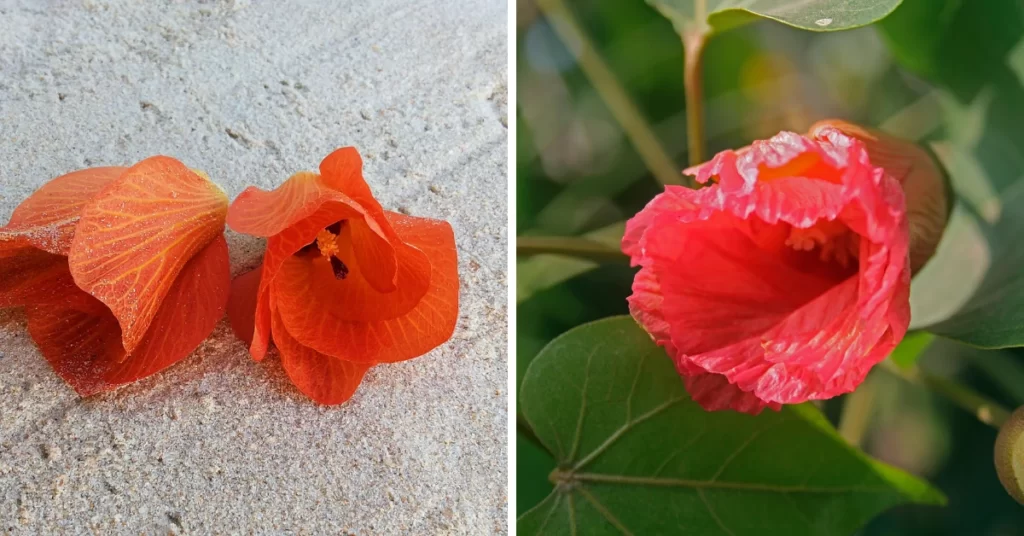
Thespesia populnea offers vibrant tropical flair with its lush foliage, bright flowers and showy seeds pods as a fast growing specimen for coastal gardens and properties.
Given a site closely replicating its preferred warm, humid habitat – rich soil, ample water and sunlight – these hardy trees flourish with minimal care aside from some pruning and monitoring for pests.
Start with high quality nursery stock if available or propagate from seed, cuttings or grafts from known superior specimens. Site carefully and pamper transplants initially with plentiful moisture until growing vigorously.
Then practice a regimen of moderate water, light fertilization, selective pruning and pest control only as required to maintain health, directing growth habit as desired. Expect relatively fast gains in height yearly.
Harvest pods for seeds or wood as needed once mature size reaches over 40 feet ultimately.
Frequently Asked Questions
What USDA zones will Thespesia populnea grow in?
Thespesia populnea grows best in zones 10-12 but may survive zone 9B with protection from frost and winter winds.
How fast does Thespesia populnea grow?
Given adequate warmth and water, growth rates average 2-3 feet per year while young. Mature trees may reach over 40 feet tall ultimately.
How do I prune Thespesia populnea trees?
Minimize pruning of mature Thespesia populnea trees aside from eliminating dead branches when dormant or light thinning for air flow/light penetration if desired. Restrict height by occasional tip pruning rather than topping major limbs to avoid permanent disfigurement from heading cuts.
Should Thespesia populnea fruit pods be stored refrigerated or at room temperature?
Refrigerate cleaned, very dry seeds in air tight containers for longest viability – up to a year depending on initial quality. Discard moldy/damaged seeds sooner.
How long does lumber from Thespesia populnea trees need to be air dried?
Debarked logs should be stored off the ground in covered, dry conditions and allowed 1-2 years air drying time per inch thickness of boards ultimately cut. Kiln drying is recommended for highest quality lumber if available.

2 thoughts on “How to Grow Thespesia Populnea (Portia Tree)”